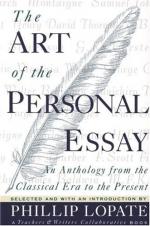
|
| Name: _________________________ | Period: ___________________ |
This test consists of 15 multiple choice questions and 5 short answer questions.
Multiple Choice Questions
1. What does the author think of the lake he revisits in "Once More to the Lake?"
(a) The lake has suffered from the effects of technology and modernization.
(b) The lake has improved because of technology.
(c) No actual lake is mentioned in the essay.
(d) The lake is just the same as the author remembered it.
2. What is the author's opinion of public executions in "The Execution of Tropmann?"
(a) Public executions are tools of the class system.
(b) Public executions are thrilling.
(c) Public executions are necessary for law and order.
(d) Public executions should be ended.
3. What event starts the essay, "On Running After One's Hat?"
(a) A church service.
(b) A birth.
(c) A hanging.
(d) A town flood.
4. Who wrote "On Being an American?"
(a) H. L. Mencken.
(b) James Baldwin.
(c) Mary McCarthy.
(d) Richard Rodriguez.
5. What might best describe the attitude of the author in "Such, Such Were the Joys..."?
(a) Joyous and spontaneous.
(b) Angry and pessimistic.
(c) Depressed and suicidal.
(d) Thoughtful and optimistic.
6. When was Virginia Woolf born?
(a) 1616 A. D.
(b) 1772 A. D.
(c) 1882 A. D.
(d) 1475 A. D.
7. Who wrote "The Execution of Tropmann?"
(a) Hubert Butler.
(b) Ivan Turgenev.
(c) Carlos Fuentes.
(d) William Hazlitt.
8. How did Virginia Woolf die?
(a) She drowned herself.
(b) She was shot by a jealous lover.
(c) Of old age.
(d) She was run over by an automobile.
9. When was Walter Benjamin Born?
(a) 1705 A.D.
(b) 1472 A.D.
(c) 1962 A.D.
(d) 1892 A.D.
10. Who wrote "Once More to the Lake"?
(a) E. B. White.
(b) Sara Suleri.
(c) Charles Lamb.
(d) Maria Edgeworth.
11. George Orwell is not the real name of the author, and yet it is used in place of the author's real name for published works. What is "George Orwell" an example of?
(a) A penciled-in name.
(b) A trick name.
(c) A fabled name.
(d) A pen name.
12. Which of the following is NOT a well-known story written by Robert Louis Stevenson?
(a) The Strange Case of Dr. Jekyll and Mr. Hyde.
(b) Treasure Island.
(c) Kidnapped.
(d) The Tell-Tale Heart.
13. Who wrote "An Apology for Idlers?"
(a) Maria Edgeworth.
(b) Robert Louis Stevenson.
(c) George Orwell.
(d) Plutarch.
14. What is a typical Virginia Woolf focus in her essays?
(a) Poverty.
(b) Joy.
(c) Death.
(d) The bounty of nature.
15. Who wrote "For My Brothers and Sisters in the Failure Business?"
(a) Seymour Krim.
(b) Gayle Pemberton.
(c) Joseph Addison.
(d) G. K. Chesterton.
Short Answer Questions
1. What is Jose Luis Borges' attitude in "Blindness?"
2. What nationality is Walter Benjamin?
3. Under what circumstances did Walter Benjamin die?
4. When was Lu Hsun born?
5. Who wrote "The Crack-Up"?
|
This section contains 432 words (approx. 2 pages at 300 words per page) |

|




